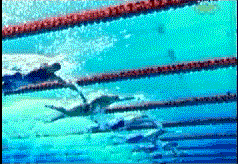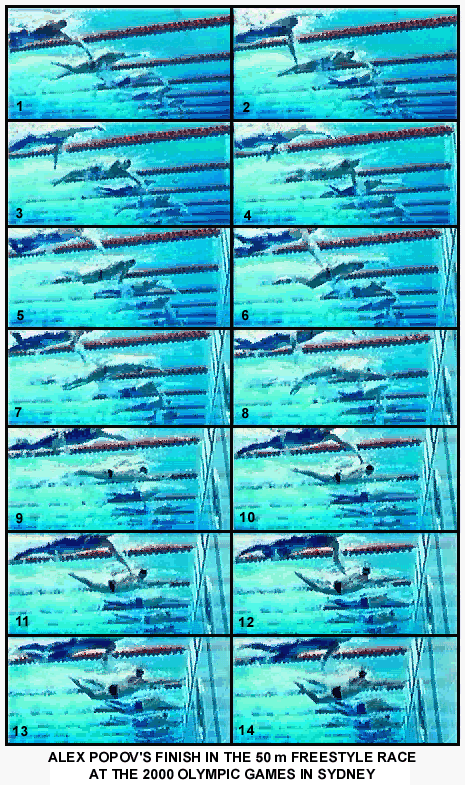

COACHING ERROR 1.1: ALEX POPOV'S FINISH IN THE 50 m FREESTYLE RACE AT THE 2000 OLYMPIC GAMES IN SYDNEY
This stroke analysis includes a moving sequence in continuous motion, a moving sequence where each frame is displayed for .5 of a second, and still frames.
The following image sequence is in continuous motion, but slower than real time. It will play through 10 times and then stop. To repeat the sequence, click the browser's "refresh" or "reload" button.

The following image sequence shows each frame for half a second. It will play through 5 times and then stop. To repeat the sequence, click the browser's "refresh" or "reload" button.

At the end of the following narrative, each frame is illustrated in detail in a sequential collage.
The Australian media broadcast Coach Gennadi Touretski's plan to introduce butterfly kicking to crawl stroke for use in finishing bursts in freestyle races. Initially, it was reported only Michael Klim would perform this way, and Alex Popov would not use this "technique". It was with some surprise that this action was observed in Popov's swim in the 50 m freestyle at the Sydney Olympic Games.
In the late 1950s, coach Harry Gallagher and swimmer Jan Andrew attempted to combine "dolphin kicking" with crawl stroke arms. After experimenting with two and three kicks per complete arm cycle, it was jettisoned as being a "bad idea." Occasionally, coaches unfamiliar with the history of swimming have tried this idea always concluding with a similar realization.
Michael Klim used this technique at the 1999 Pan Pacific Championships in Sydney in the 100 m freestyle final, when he recorded a time that was slower than his semi-final performance at that meet.
There is no justifiable biomechanical principle for mixing dolphin kicking with crawl stroke arms. The alternating arms of crawl stroke require alternating kicks to counterbalance their alternating force production. A dolphin kick does not produce counterbalancing forces in concert with alternating arms. The result is that powerful double-leg kicks elevate the hips and force the shoulders down, dramatically slowing the progress of the swimmer. In this analysis, Alex Popov commences the sequence in medal contention but over the space of the final two meters drops to sixth place.
In the summer of 2000, Alex Popov set a new world record in the 50-m freestyle with a time of 21.64. In this competition, Popov recorded 22.15 seconds in the heat, 22.17 in the semi-final, and 22.24 in the final where he finished sixth. From the following analysis, it is obvious as to what was one of the reasons why his final was so slow. In the biomechanical analysis that was conducted during the Olympic Games, a measure of the finish phase (5 m to the wall touch) showed Popov to be the slowest of the eight finalists taking 2.29 s compared to the best by Lorenzo Vismara of Italy of 2.13 s.
This analysis attempts to explain the kinematic features that justify NOT combining double-leg kicking with crawl stroke arms in swimming.
Notable Features
The introduction of a dolphin kick at the very end of this race served to slow the swimmer dramatically. The reactions to the kick were vertical hip and head movements, rather than horizontal propulsion. This "crazy" action cost Alex Popov any chance of a medal in this race. It was less than a fitting finale for his great Olympic career.

Return to Table of Contents for this section.
